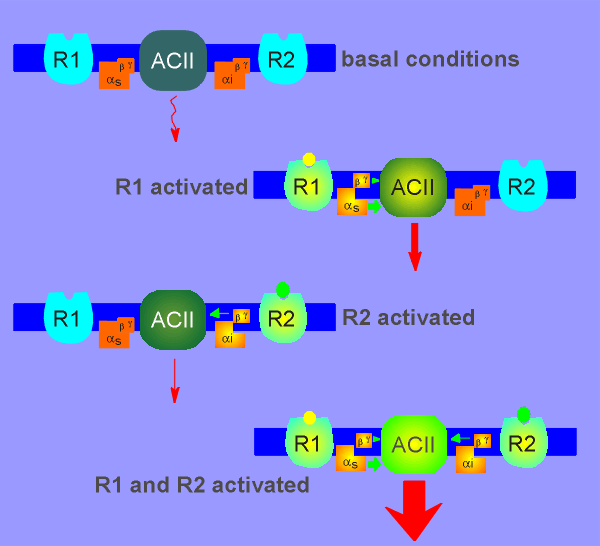 The top diagram
shows basal conditions with the AC producing a "trickle" of cyclic AMP (red
arrow).
The top diagram
shows basal conditions with the AC producing a "trickle" of cyclic AMP (red
arrow).Because they are regulated by multiple mechanisms a number of the adenylyl cyclase isoforms have the possibility to act as a coincidence detector.
As an example consider adenylyl cyclase II, a form of the enzyme that is not inhibited by alpha(i) and is activated by beta/gamma subunits.
Consider the situation given in the diagrams below:
 The top diagram
shows basal conditions with the AC producing a "trickle" of cyclic AMP (red
arrow).
The top diagram
shows basal conditions with the AC producing a "trickle" of cyclic AMP (red
arrow).
In the second diagram receptor R1 has been activated by its ligand (yellow ball) and the ligand-receptor complex in turn activates Gs.
The alpha(s) gives a strong activation of adenylyl cyclase and thus high cyclic AMP output (thick red arrow).
The beta/gamma subunit has only a minor effect on the adenylyl cyclase because, relative to the alpha subunit, beta/gammas are only weak activators of adenylyl cyclase (about 5-fold weaker than the alpha subunits).
In the third diagram receptor R2 is activated by its ligand (green ball) but gives only weak activation of adenylyl cyclase via the beta/gamma.
In the last diagram both R1 and R2 are activated and we have an extremely strong activation of AC and thus a very high output of cyclic AMP (far higher than the sum of the output of R1 and R2 alone).
The reason is twofold.... first, beta/gamma subunits are know to potentate the effects of alpha(s) subunits (i.e. while they are only weak activators themselves they can make the response to alpha(s) much stronger).
Secondly, in the brain there are very high levels of Gi proteins.
This means that activation of Gi will produce large quantities of beta/gamma (far larger quantities than that coming from Gs in the situation depicted in the second diagram).
The large quantity of beta/gamma coming from the Gi protein potentates the alpha(s) and, thus, when receptor R1 and R2 are activated simultaneously (4th diagram), the response is far higher that with activation of either receptor alone.
This behavior is known as coincidence detection (the cell detects that two events have occured simultaneously, i.e. release of ligand 1 and ligand 2).
Coincidence detection is thought to play an important role in memory and learning.